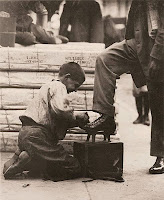During the Industrial Revolution, children as young as four were employed in production factories with dangerous, and often fatal, working conditions. Based on this understanding of the use of children as labourers, it is now considered by wealthy countries to be a human rights violation, and is outlawed, while some poorer countries may allow or tolerate child labour. Child labour can also be defined as the full-time employment of children who are under a minimum legal age.
The Victorian era became notorious for employing young children in factories and mines and as chimney sweeps. Child labour played an important role in the Industrial Revolution from its outset, often brought about by economic hardship, Charles Dickens for example worked at the age of 12 in a blacking factory, with his family in debtor's prison. The children of the poor were expected to help towards the family budget, often working long hours in dangerous jobs for low pay,earning 10-20% of an adult male's wage. In England and Scotland in 1788, two-thirds of the workers in 143 water-powered cotton mills were described as children. In 19th-century Great Britain, one-third of poor families were without a breadwinner, as a result of death or abandonment, obliging many children to work from a young age.
Two girls protesting child labour (by calling it child slavery) in the 1909 New York City Labor Day parade. In coal mines, children would crawl through tunnels too narrow and low for adults.
Children also worked as errand boys, crossing sweepers, shoe blacks, or selling matches, flowers and other cheap goods. Some children undertook work as apprentices to respectable trades, such as building or as domestic servants (there were over 120,000 domestic servants in London in the mid-18th century). Working hours were long: builders worked 64 hours a week in summer and 52 in winter, while domestic servants worked 80 hour weeks.
Children as young as three were put to work. A high number of children also worked as prostitutes.Many children (and adults) worked 16 hour days. As early as 1802 and 1819 Factory Acts were passed to regulate the working hours of workhouse children in factories and cotton mills to 12 hours per day. These acts were largely ineffective and after radical agitation, by for example the "Short Time Committees" in 1831, a Royal Commission recommended in 1833 that children aged 11–18 should work a maximum of 12 hours per day, children aged 9–11 a maximum of eight hours, and children under the age of nine were no longer permitted to work. This act however only applied to the textile industry, and further agitation led to another act in 1847 limiting both adults and children to 10 hour working days.
An estimated 1.7 million children under the age of fifteen were employed in American industry by 1900.[11] In 1910, over 2 million children in the same age group were employed in the United States.
The Victorian era became notorious for employing young children in factories and mines and as chimney sweeps. Child labour played an important role in the Industrial Revolution from its outset, often brought about by economic hardship, Charles Dickens for example worked at the age of 12 in a blacking factory, with his family in debtor's prison. The children of the poor were expected to help towards the family budget, often working long hours in dangerous jobs for low pay,earning 10-20% of an adult male's wage. In England and Scotland in 1788, two-thirds of the workers in 143 water-powered cotton mills were described as children. In 19th-century Great Britain, one-third of poor families were without a breadwinner, as a result of death or abandonment, obliging many children to work from a young age.
Two girls protesting child labour (by calling it child slavery) in the 1909 New York City Labor Day parade. In coal mines, children would crawl through tunnels too narrow and low for adults.
Children also worked as errand boys, crossing sweepers, shoe blacks, or selling matches, flowers and other cheap goods. Some children undertook work as apprentices to respectable trades, such as building or as domestic servants (there were over 120,000 domestic servants in London in the mid-18th century). Working hours were long: builders worked 64 hours a week in summer and 52 in winter, while domestic servants worked 80 hour weeks.
Children as young as three were put to work. A high number of children also worked as prostitutes.Many children (and adults) worked 16 hour days. As early as 1802 and 1819 Factory Acts were passed to regulate the working hours of workhouse children in factories and cotton mills to 12 hours per day. These acts were largely ineffective and after radical agitation, by for example the "Short Time Committees" in 1831, a Royal Commission recommended in 1833 that children aged 11–18 should work a maximum of 12 hours per day, children aged 9–11 a maximum of eight hours, and children under the age of nine were no longer permitted to work. This act however only applied to the textile industry, and further agitation led to another act in 1847 limiting both adults and children to 10 hour working days.
An estimated 1.7 million children under the age of fifteen were employed in American industry by 1900.[11] In 1910, over 2 million children in the same age group were employed in the United States.













No comments:
Post a Comment